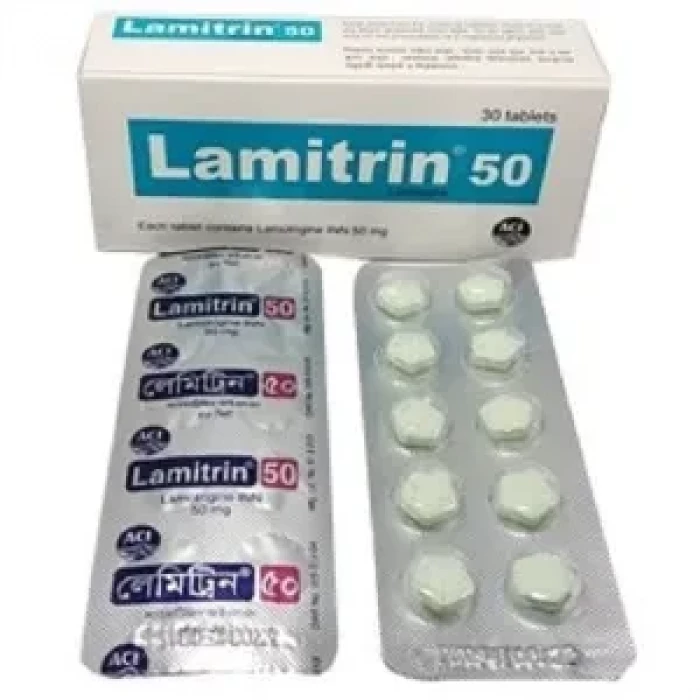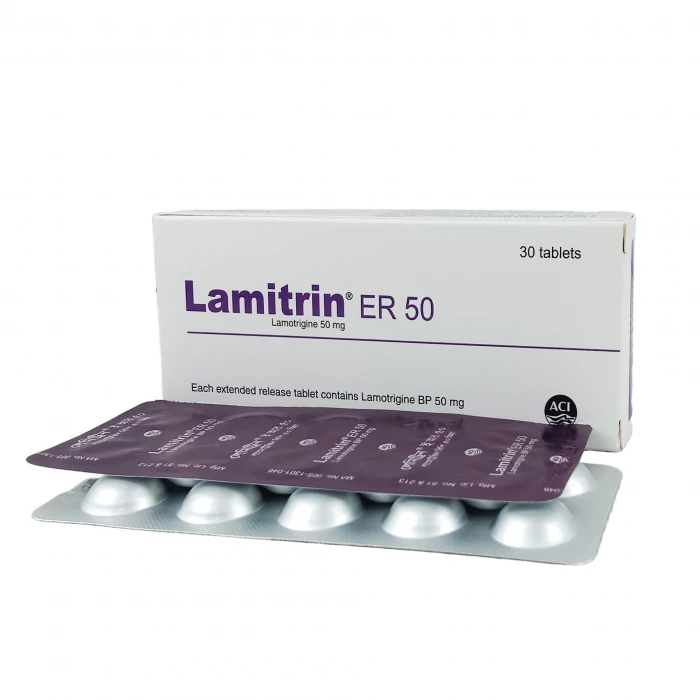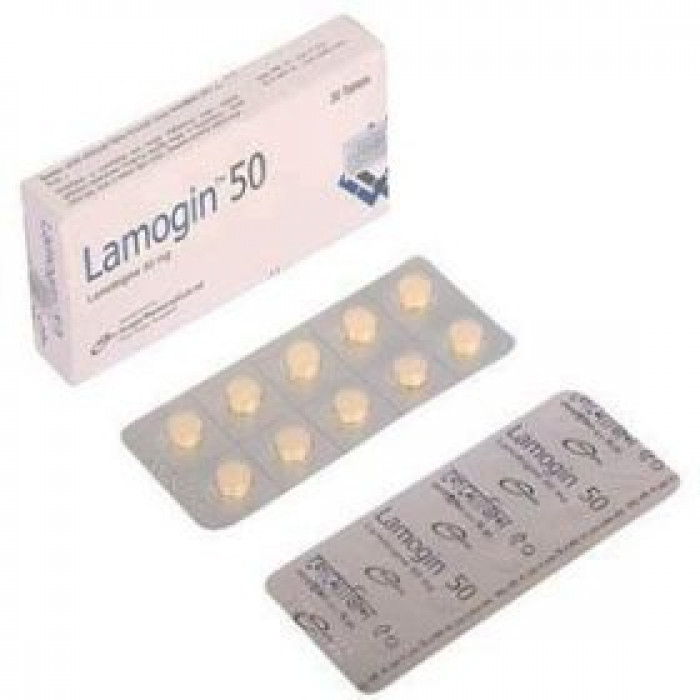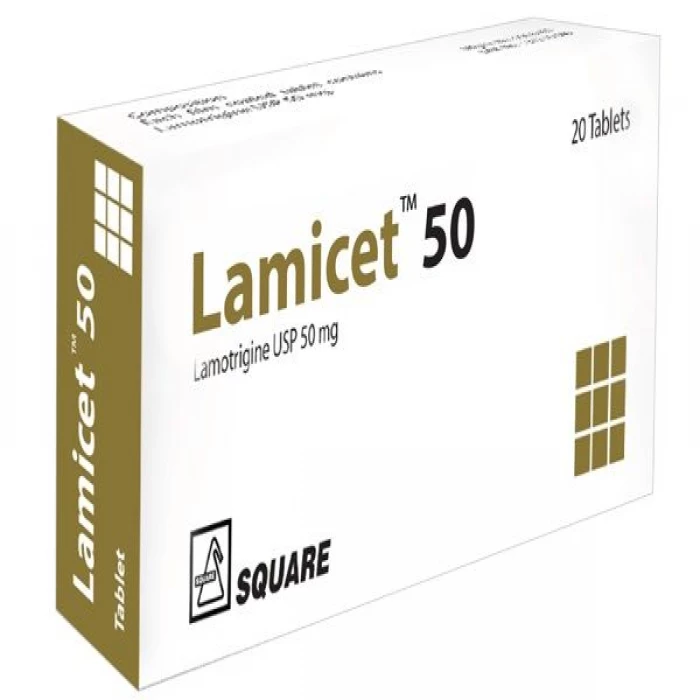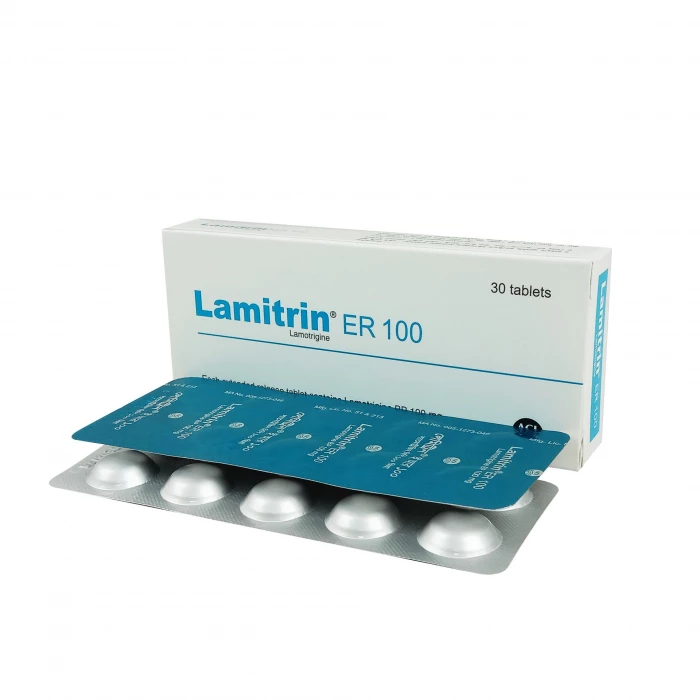

✔ 100% Authentic Product

100% Genuine Products, Guaranteed
Safe & Secure Payments, Always
Fast, Secure & Efficient Delivery
Proper Packaging
Cashback offer (Optional):
🔹 Foreign manufacturer products are not applicable for Cashback offer
 Cash on Delivery - All over Bangladesh
Cash on Delivery - All over Bangladesh Urgent Delivery - 2 Hours Dhaka City
Urgent Delivery - 2 Hours Dhaka City ফ্রি ডেলিভারি! - ১৪৯৯ টাকা+ অর্ডারে ঢাকা
শহরে ।
ফ্রি ডেলিভারি! - ১৪৯৯ টাকা+ অর্ডারে ঢাকা
শহরে । ফ্রি ডেলিভারি! - ২৯৯৯ টাকা+ অর্ডারে ঢাকার
বাহিরে ।
ফ্রি ডেলিভারি! - ২৯৯৯ টাকা+ অর্ডারে ঢাকার
বাহিরে ।
✅ Description:
Lamotrigine/Anti-epileptic Medicine
- Epilepsy: Used with other medications to manage seizures.
- Bipolar I Disorder: Long-term management to prolong the time between mood episodes in adults.
- Avoid sunlight; use sunscreen and wear protective clothing.
- Inform your doctor if you have a history of depression, heart problems, mood disorders, or aseptic meningitis after taking this medication.
- Use with caution during pregnancy and breastfeeding.
- Not recommended for children under 2 years of age.
- Monitor for thoughts of self-harm; seek immediate medical attention if these occur.
Safety Advices

Alcohol
UNSAFE
Lamitrin 25 may cause excessive drowsiness when taken with alcohol.

Pregnancy
CONSULT YOUR DOCTOR
Lamitrin 25 may be unsafe during pregnancy. Animal studies have shown harmful effects on the developing baby. Your doctor will consider the benefits and potential risks before prescribing it.

Breastfeeding
CONSULT YOUR DOCTOR
Lamitrin 25 is probably safe during breastfeeding. Limited human data suggest it does not pose a significant risk to the baby. Monitor the baby for rash, sleepiness, or poor sucking, and get periodic platelet count and liver function tests.

Driving
CAUTION
Lamitrin 25 may cause dizziness and double vision, affecting your ability to drive.

Kidney
CONSULT YOUR DOCTOR
Lamitrin 25 should be used with caution in patients with kidney disease. Dose adjustment may be necessary. Consult your doctor.

Liver
CONSULT YOUR DOCTOR
Lamitrin 25 should be used with caution in patients with liver disease. Dose adjustment may be necessary. Consult your doctor.
✔️ Uses of Lamitrin 25
- Epilepsy/Seizures
- Bipolar disorder
✔️ How does Lamitrin 25 work?
It acts by inhibiting sodium currents (which is out of control in epileptic patients) via suppression of the release of glutamate (an excitatory brain chemical).
✔️ Side Effects of Lamitrin 25
- Nausea
- Vomiting
- Sleepiness
- Dizziness
- Blurred vision
- Double vision
- Back pain
- Dryness in mouth
- Insomnia (difficulty in sleeping)
- Abdominal pain
- Impaired coordination
- Nasal congestion (stuffy nose)
- Infection
✔️ Quick Suggestions:
✔️ Indication of Lamitrin 25
Lamitrin 25 belongs to a group of medicines called anti-epileptics. It is used to treat two conditions, epilepsy and bipolar disorder.
✔️ Mechanism of Action for Lamotrigine
1. Inhibition of Sodium Channels:
- Lamotrigine's primary mechanism resembles that of phenytoin and carbamazepine, involving the inhibition of voltage-sensitive sodium channels.
- By stabilizing neuronal membranes, it modulates the release of presynaptic excitatory neurotransmitters.
- Specifically, lamotrigine likely inhibits sodium currents through selective binding to inactive sodium channels, reducing the release of the excitatory amino acid, glutamate.
2. Application in Bipolar Disorder:
- The anticonvulsant mechanism of lamotrigine is thought to be the same as its mechanism for managing bipolar disorder, involving the stabilization of neuronal membranes and modulation of neurotransmitter release.
3. Binding Properties and Receptor Interaction:
- Serotonin Receptor: Weak inhibitory effect on the serotonin 5-HT3 receptor.
- Adenosine Receptors: Weak binding to Adenosine A1/A2 receptors.
- Adrenergic Receptors: Weak binding to α1/α2/β adrenergic receptors.
- Dopamine Receptors: Weak binding to dopamine D1/D2 receptors.
- GABA Receptors: Weak binding to GABA A/B receptors.
- Histamine Receptor: Weak binding to histamine H1 receptors.
- Opioid Receptors: Weak inhibitory effects at sigma opioid receptors and weak binding to the κ-opioid receptor (KOR).
- Muscarinic Receptors: Weak binding to mACh receptors.
- Serotonin Receptors: Weak binding to serotonin 5-HT2 receptors.
4. Inhibition of Calcium Currents:
- An in vivo study has shown that lamotrigine inhibits Cav2.3 (R-type) calcium currents, which may contribute to its anticonvulsant effects.
This diverse receptor interaction and channel inhibition contribute to lamotrigine's efficacy in treating epilepsy, bipolar disorder, and possibly some neuropathic pain states.
✔️ Dosage & Administration of Lamitrin 25
Adult Dose
Oral Epilepsy:
- Initial Dose: 25 mg once daily for 2 weeks.
- Second Phase: 50 mg once daily for 2 weeks.
- Maintenance Dose: Increase by 50-100 mg every 1-2 weeks to a usual dose of 100-200 mg daily, as a single dose or in 2 divided doses. Some patients may require up to 500 mg daily.
Adjunct in Epilepsy: With Valproate:
- Initial Dose: 25 mg on alternate days for 2 weeks.
- Second Phase: 25 mg once daily for 2 weeks.
- Maintenance Dose: Increase by 25-50 mg every 1-2 weeks to a usual dose of 100-200 mg daily in 1-2 divided doses.
With Enzyme-Inducing Antiepileptics (excluding Valproate):
- Initial Dose: 50 mg once daily for 2 weeks.
- Second Phase: 50 mg twice daily for 2 weeks.
- Maintenance Dose: Increase by 100 mg every 1-2 weeks to a usual dose of 200-400 mg daily in 2 divided doses; some patients may require up to 700 mg daily.
With Oxcarbazepine (excluding enzyme-inducing or -inhibiting antiepileptics):
- Initial Dose: 25 mg once daily for 2 weeks.
- Second Phase: 50 mg once daily for 2 weeks.
- Maintenance Dose: Increase by 50-100 mg every 1-2 weeks to a usual dose of 100-200 mg daily in 1-2 divided doses; some patients may require up to 500 mg daily.
Bipolar Disorder: Monotherapy:
- Initial Dose: 25 mg once daily for 2 weeks.
- Second Phase: 50 mg once daily for 2 weeks.
- Maintenance Dose: Double the daily dose weekly to a usual dose of 200 mg daily. Maximum dose is 200 mg/day.
With Valproate:
- Initial Dose: 25 mg every other day for 2 weeks.
- Second Phase: 25 mg once daily for 2 weeks.
- Maintenance Dose: Double the daily dose weekly to a usual dose of 100 mg daily.
With Enzyme-Inducing Antiepileptics (excluding Valproate):
- Initial Dose: 50 mg once daily for 2 weeks.
- Second Phase: 100 mg daily in 2 divided doses for 2 weeks.
- Maintenance Dose: Increase by 100 mg weekly to a usual dose of 400 mg daily in 2 divided doses.
Hepatic Impairment:
- Moderate Impairment (Child-Pugh category B): Reduce dose by about 50%.
- Severe Impairment (Child-Pugh category C): Reduce dose by about 75%.
✔️ Lamitrin 25 Child Dose
Oral Epilepsy (Children >12 years):
- Initial Dose: 25 mg once daily for 2 weeks.
- Second Phase: 50 mg once daily for 2 weeks.
- Maintenance Dose: Increase by 50-100 mg every 1-2 weeks to a usual dose of 100-200 mg daily, as a single dose or in 2 divided doses. Some patients may require up to 500 mg daily.
Adjunct in Epilepsy (Children): With Valproate:
- Initial Dose: 0.15 mg/kg once daily for 2 weeks.
- Second Phase: 0.3 mg/kg once daily for 2 weeks.
- Maintenance Dose: Increase by 0.3 mg/kg every 1-2 weeks to a usual dose of 1-5 mg/kg once daily or in 2 divided doses.
Lamitrin 25 is not recommended for children under 12 years for the treatment of epilepsy.
✔️ Renal Dose of Lamitrin 25
Renal Impairment:
- Use caution and consider dose reduction in significant renal impairment.
✔️ Interaction
1. Enhanced Metabolism:
- Metabolism of Lamitrin 25 is enhanced by enzyme-inducing drugs such as:
- Phenytoin
- Carbamazepine
- Phenobarbitone
- Primidone
- Rifampicin
- Ethinyloestradiol/levonorgestrel combination
2. Reduced Metabolism:
- The metabolism of Lamitrin 25 is reduced by sodium valproate.
✔️ Contraindications
Hypersensitivity.
✔️ Pregnancy & Lactation
Pregnancy Category C. Lamotrigine is excreted in human milk. Because of the potential for serious adverse reactions in nursing infants from Lamotrigine, a decision should be made whether to discontinue nursing or discontinue the drug, taking into account the importance of the drug to the mother.
✔️ Precautions for Lamitrin 25 (Lamotrigine)
1. Hepatic or Renal Impairment:
- Closely monitor patients with liver or kidney impairment.
2. Monitoring:
- Monitor children’s body weight.
- Advise patients to report any hypersensitivity reactions.
- Avoid abrupt withdrawal unless severe skin reactions develop.
3. Driving and Operating Machinery:
- May impair the ability to drive or operate machinery. Use with caution.
4. Pregnancy and Lactation:
- Pregnancy: Consult your doctor before use.
- Lactation: Distributed into human breast milk; use with caution.
5. Serious Risks:
- Serious skin rashes
- Blood dyscrasias
- Suicidal behavior
- Aseptic meningitis
- These can occur in both adult and pediatric populations.
✔️ Storage:
Keep out of reach of children, Store in a dry place, below 25°C temperature, and protected from light.
Disclaimer:
ePharma sole intention is to ensure that its consumers get proper
information as musch as possible. Although we do not guarantee the
accuracy and the completeness of the information that provided and
here information is for informational purposes only.
The information contained herein should NOT be used as a substitute
for the advice of a qualified physician. This may not cover
everything about particular health conditions,
lab tests, medicines, all possible side effects, drug interactions,
warnings, alerts, etc. Please consult your healthcare professional
and discuss all your queries related to any disease or medicine. We
intend to support, not replace, the doctor-patient relationship.




